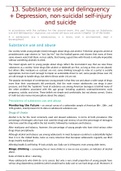13. Substance use and delinquency
+ Depression, non-suicidal self-injury
and suicide
In accordance with the syllabus for the second exam, this part focuses on Substance
use and delinquency + depression, non-suicidal self-injury and suicide (chapter 13 of the book).
A = adolescent; ace = adolescence; = = is/are; envt = environment, dvpt =
development.
Substance use and abuse
Our society sends young people mixed messages about drugs and alcohol. Television programs aimed at
preadolescents urge viewers to “Just Say No!” but the football games and sitcoms that many of these
same viewers watch tell them, no less subtly, that having a good time with friends is virtually impossible
without something alcoholic to drink.
The mixed signals sent to young people about drugs reflect the inconsistent way that we view these
substances as a society: Some drugs (like alcohol or Adderall) are fine, as long as they are not abused,
but others (like marijuana or ecstasy) are not; some drinking (enough to relax at a party) is socially
appropriate, but too much (enough to impair an automobile driver) is not; some people (those over 21)
are old enough to handle drugs, but others (those under 21) are not.
The popular stereotype of contemporary young people is that they use and abuse a wide range of drugs
more than their counterparts did previously, that the main reason adolescents use drugs is peer
pressure, and that the “epidemic” level of substance use among American teenagers is behind many of
the other problems associated with this age group—including academic underachievement, early
pregnancy, suicide, and crime. These beliefs are simple and comfortable, but not always correct. Grains
of truth but also many misconceptions about the subject.
Prevalence of substance use and abuse
Monitoring the Future = an annual survey of a nationwide sample of American 8th-, 10th-, and
12th-graders, mainly known for its data on adolescent substance use.
Drugs of choice
Alcohol is by far the most commonly used and abused substance, in terms of both prevalence (the
percentage of teenagers who have ever used the drug) and recency of use (the percentage of teenagers
who have used the drug within the last month), followed by marijuana and tobacco.
After marijuana and tobacco, however, the percentage of young people who have tried various other
drugs drops precipitously.
Although alcohol and tobacco use among adolescents in most European countries is substantially higher
than it is in the United States, twice as many American than European adolescents regularly use illicit
drugs (mainly marijuana).
Affecting health & well-being look at daily use. Daily use is infrequent, even among older teens.
Binge drinking = consuming five or more drinks in a row on one occasion, an indicator of alcohol
abuse.
Rates of drink & drive = alarming.
Many adolescents who drink do so to excess. But only a very small proportion of young people have
serious drug dependency problems (which would lead to daily use) or use hard drugs at all. Moreover, it
, is very unlikely that drug and alcohol use lurks behind the wide assortment of adolescent problems for
which it is so frequently blamed. Rather, the pattern suggests that most adolescents have experimented
with alcohol, marijuana, and tobacco; that many have used one or more of these drugs regularly; that
alcohol is clearly the drug of choice among teenagers (a substantial proportion of whom drink to
excess); and that most teenagers have not experimented with other drugs.
Changes in substance use over time
Marijuana = on the rise. Continuing increase in the proportion of high school students who get high
daily.
Alcohol use has declined slowly. Teen smoking decreased a lot (price of cigarettes). High price of
cigarettes is by far the best thing to do to be efficient. continuing increase in the proportion of high
school students who get high daily.
No one really knows why rates of adolescent substance use fluctuate over time, except, perhaps,
because of fluctuations in price and availability. We know that adolescents’ drug use fluctuates with
changes in their perceptions of how harmful and disapproved of drug use is, but scientists have not
been able to determine what influences these perceptions, although it is likely that the messages
teenagers receive about drugs—from parents, teachers, and mass media—are important.
Interestingly, the once-existent gender gap in drug use, with males more likely to use and abuse drugs,
has all but disappeared for alcohol, marijuana, and cigarettes, and has narrowed substantially for other
drugs as well.
Experimentation with drugs is less common among younger teens than it had been in the past. Rates of
substance use among 8th-graders are important to watch, because the chances of becoming addicted to
alcohol or nicotine are dramatically increased when substance use begins prior to age 15.
Drugs and the adolescent brain
The potential for addiction is much greater in adolescence than adulthood.
[See chapter 2: limbic system/dopamine etc].
Certain drugs make users feel good primarily because they affect the same receptors that are sensitive
to the dopamine that is in the brain naturally. experiences in early adolescence, when the limbic system
is changing naturally, can permanently affect the way the dopamine system functions. various brain
systems and regions change during different periods of development, and it is during periods of change
that these brain systems are most easily and irreversibly affected by outside influences.
Repeated exposure to drugs during this period of heightened malleability in the limbic system can affect
the brain in ways that make it necessary to use drugs in order to experience normal amounts of
pleasure.
This permanent alteration in the dopamine system is more likely to happen in adolescence, when the
limbic system is still malleable, than in adulthood, when it is less changeable.
Compared with individuals who delay drinking until they are 21, people who begin drinking in early
adolescence (before age 14) are 7 times more likely to binge drink as teenagers and 5 times more
likely to develop a substance abuse or dependence disorder at some point in their life.
Individuals who begin smoking regularly before age 14 are at greater risk for nicotine dependence as
adults than are those who start in late adolescence.
As don’t feel the negative consequences of drinking as profoundly as adults do. Moreover, juveniles feel
the positive effects of alcohol more intensely than adults.
The lasting effects of alcohol on brain functioning are worse in adolescence than in adulthood (periods
of plasticity).
Especially vulnerable to the harmful effects of alcohol is the hippocampus, which is important for
memory and, along with the prefrontal cortex, for “putting the brakes” on impulsive behaviour. Alcohol





